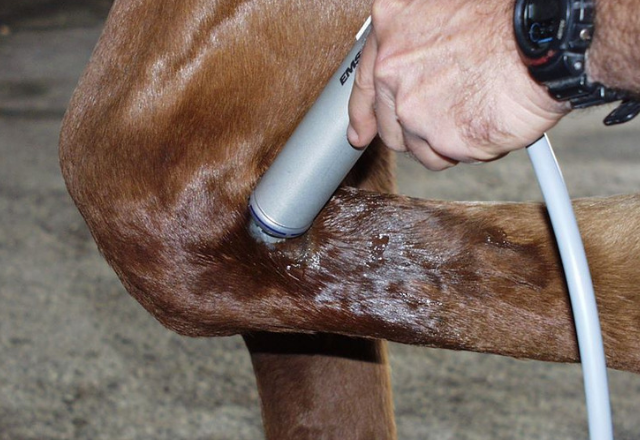Extracorporeal shock wave therapy (ESWT) has become a highly accepted technology for treating musculoskeletal problems, soft-tissue injuries and bone injuries in horses.
Extracorporeal shock wave therapy (ESWT) is a method of applying energy waves to hard or soft tissue in a particular area of the body. ESWT is a non-invasive procedure that utilizes the production of acoustic sound waves to produce high pressure waves that are focused at a point of tissue or bone to stimulate healing.
When the shock waves meet interfaces of different impedance (i.e. bone/soft tissue interface) changes within the tissue are stimulated and created. These include an increase in blood flow, direct cellular effects, activation of osteogenic factors (the process of laying down new bone) and a direct analgesic (pain relieving) effect.
Developed for human use in breaking up kidney stones, the technique has been adopted by veterinarians to reduce pain and stimulate healing in some types of injuries. “Extracorporeal” refers to the fact that the treatment is given from outside the horse’s body, in contrast to oral medications, injections, or surgery that are considered more invasive.
How can shockwave therapy help your horse?
Studies have shown that it reduces inflammation, thereby reducing pain as it promotes healing. It appears to be especially effective where ligaments attach to bone or where there is an arthritis problem. ESWT has been used successfully to treat:
- Bowed tendons
- Suspensory ligament injuries
- Stress fractures
- Splint bone fractures
- Bone spavin
- Navicular syndrome
- Vertebral spinal pain/kissing spine
- Sacro-iliac conditions (Hunter Bumps)
- Back pain
- Bucked shins
ESWT has been proven effective in many research studies. In one study researchers reported that 79% of horses diagnosed with bone spavin (A form of Hock Arthritis) had an improved lameness score following ESWT. In another study they reported successfully treating chronic suspensory disease in 80% of affected horses after only three ESWT sessions.
ESWT can be done on an out-patient basis at the hospital or at an owner’s barn. Patients are sedated and treated standing, taking approximately 10-15 minutes once the sedation has taken effect. It customarily takes from one to three treatments (two to three weeks apart), depending upon the severity of the condition and the type of tissue being treated.


